Optimizing Agricultural Sustainability Through Land Use Changes Under the CAP Framework Using Multi-Criteria Decision Analysis in Northern Greece
Abstract
1. Introduction
2. Materials and Methods
2.1. Study Area and Farmer Groups
2.2. Methodology—Weighted Goal Programming
- Specification of a set of objectives deemed critical for farmers;
- Establishment of the payoff matrix corresponding to the identified objectives;
- Utilization of the matrix to compute a series of weights that mirror farmers’ preferences.
2.3. Model Specification
2.3.1. Variables
2.3.2. Objectives
- 1.
- Minimization of variable cost (VC) refers to a decrease in the overall expenditure allocated to inputs. Variable costs in this study include expenses for seeds, fertilizers, pesticides, fuel, and machinery repairs (reduction up to 15%).
- 2.
- Minimization of labor (LAB) costs refers to a reduction in the total number of working hours. **Labor is measured in total hours of fieldwork required per crop, based on standard regional data (reduction up to 20%).
- 3.
- Minimization of fertilizer (FER) use. Fertilizer use is measured in total kilograms of active nutrients applied (reduction up to 20%).
- 4.
- Maximization of gross margin (GM). Gross margin in this study is defined as total revenue (yield per hectare multiplied by price) minus total variable costs (from 15% to 20%).
- 5.
- Minimization of water use (WAT): decrease in the total cubic meters per crop cultivation.
2.3.3. Constraints
- 1.
- Total cultivated land: Up to 100 hectares per farmer group.
- 2.
- Labor: The total labor hours for each crop must not surpass the total available hours.
- 3.
- Fertilizers: The total quantity of fertilizer allocated to each crop within the area will not surpass the overall available fertilizer.
- 4.
- Common agricultural policy: The CAP incentivizes many farmers to adhere to its regulations to secure subsidies and bolster their earnings. Consequently, it is crucial for the model to incorporate CAP-related constraints, such as the prudent utilization of water (Report on the CAP Strategic Plan) [26]. In this regard, it has been projected beforehand that this entails potential water conservation of no less than 20%.
- 5.
- Market restrictions and other restrictions: Impose a maximum limit on cultivation expansion considering the market limitations. The term “market restriction,” as used in the model, refers to practical market limitations [17] rather than institutional or regulatory CAP rules. Specifically, some crops—although not bound by formal constraints—are subject to external limits related to demand, marketing capacity, or the availability of appropriate infrastructure. These factors impose a realistic upper boundary on the area that can be devoted to such crops in the short term. They are incorporated into the model as a safeguard to prevent overly optimistic or impractical crop planning recommendations;
- 6.
- While crop rotation is a key GAEC 7 requirement, a specific rotational constraint was not included in this single-period optimization model. The model’s output is designed to be assessed for its rotational feasibility by farm advisors as a subsequent step.
2.3.4. Modeling of CAP Interventions
3. Results
3.1. The Loudias Farmer Group
3.2. The Agia Paraskevi Farmer Group—Current Crop Plan
3.2.1. Optimal Land Change of the Agia Paraskevi Farmer Group
3.2.2. Objective Analysis of the Agia Paraskevi Farmer Group
3.3. The Ryakio Farmer Group—Current Crop Plan
3.3.1. Optimal Land Change of the Ryakio Farmer Group
3.3.2. Objective Analysis of the Ryakio Farmer Group
4. Discussion
5. Conclusions
Author Contributions
Funding
Data Availability Statement
Acknowledgments
Conflicts of Interest
Abbreviations
| VC | Variable Cost |
| GM | Gross Margin |
| LAB | Labor Use |
| FER | Fertilizer Use |
| WAT | Water Use |
References
- Aznar-Sánchez, J.A.; Velasco-Muñoz, J.F.; López-Felices, B.; Román-Sánchez, I.M. An Analysis of Global Research Trends on Greenhouse Technology: Towards a Sustainable Agriculture. Int. J. Environ. Res. Public Health 2020, 17, 664. [Google Scholar] [CrossRef]
- Nelson, G.C.; Rosegrant, M.W.; Palazzo, A.; Gray, I.; Ingersoll, C.; Robertson, R. Food Security, Farming, and Climate Change to 2050: Scenarios, Results, Policy Options; International Food Policy Research Institute: Washington, DC, USA, 2010. [Google Scholar]
- Velasco-Muñoz, J.F.; Mendoza, J.M.F.; Aznar-Sánchez, J.A.; Gallego-Schmid, A. Circular Economy Implementation in the Agricultural Sector: Definition, Strategies and Indicators. Resour. Conserv. Recycl. 2021, 170, 105618. [Google Scholar] [CrossRef]
- Mohamad, R.S.; Verrastro, V.; Cardone, G.; Bteich, M.R.; Favia, M.; Moretti, M.; Roma, R. Optimization of Organic and Conventional Olive Agricultural Practices from a Life Cycle Assessment and Life Cycle Costing Perspectives. J. Clean. Prod. 2014, 70, 78–89. [Google Scholar] [CrossRef]
- Esposito, B.; Sessa, M.R.; Sica, D.; Malandrino, O. Towards Circular Economy in the Agri-Food Sector. A Systematic Literature Review. Sustainability 2020, 12, 7401. [Google Scholar] [CrossRef]
- Sanchi, I.D.; Alhassan, Y.J.; Sabo, A.Y. Rising Costs of Farm Inputs and Its Implication on 2022 Wet Season Farming in Northwest Sub Region of Nigeria. Off. Publ. Direct Res. J. Agric. Food Sci. 2022, 10, 144–150. [Google Scholar] [CrossRef]
- Geissdoerfer, M.; Savaget, P.; Bocken, N.M.P.; Hultink, E.J. The Circular Economy—A New Sustainability Paradigm? J. Clean. Prod. 2017, 143, 757–768. [Google Scholar] [CrossRef]
- Common Agricultural Policy 2023–2027. Available online: https://www.consilium.europa.eu/en/policies/cap-funding-rules-2023-2027/ (accessed on 22 March 2025).
- Jongeneel, R.; Gonzalez-Martinez, A. Implementing the EU Eco-Scheme in the Netherlands: A Results-Based Points System Approach. EuroChoices 2023, 22, 20–27. [Google Scholar] [CrossRef]
- Zieliński, M.; Józwiak, W.; Żak, A.; Rokicki, T. Development of Eco-Schemes as an Important Environmental Measure in Areas Facing Natural or Other Specific Constraints Under the Common Agriculture Policy 2023–2027: Evidence from Poland. Sustainability 2025, 17, 2781. [Google Scholar] [CrossRef]
- Galioto, F.; Nino, P. Investigating the Reasons behind the Choice to Promote Crop Diversification Practices through the New CAP Reform in Europe. Land Use Policy 2023, 133, 106861. [Google Scholar] [CrossRef]
- European Commission. Approved 28 CAP Strategic Plans (2023–2027): Summary Overview for 27 Member States; European Union: Brussels, Belgium, 2023. [Google Scholar]
- da S. Alves, S.A.F.; Coelho, V.H.R.; Tsuyuguchi, B.B.; de O. Galvão, C.; Rêgo, J.C.; Almeida, C.D.N.; Abels, A.; Pinnekamp, J.; Rufino, I.A.A. Spatial Multicriteria Approach to Support Water Resources Management with Multiple Sources in Semi-Arid Areas in Brazil. J. Environ. Manag. 2021, 297, 113399. [Google Scholar] [CrossRef]
- Radmehr, A.; Bozorg-Haddad, O.; Loáiciga, H.A. Developing Strategies for Agricultural Water Management of Large Irrigation and Drainage Networks with Fuzzy MCDM. Water Resour. Manag. 2022, 36, 4885–4912. [Google Scholar] [CrossRef]
- Hayashi, K. Multicriteria Analysis for Agricultural Resource Management: A Critical Survey and Future Perspectives. Eur. J. Oper. Res. 2000, 122, 486–500. [Google Scholar] [CrossRef]
- Lombardi, P.; Todella, E. Multi-Criteria Decision Analysis to Evaluate Sustainability and Circularity in Agricultural Waste Management. Sustainability 2023, 15, 14878. [Google Scholar] [CrossRef]
- Kouriati, A.; Tafidou, A.; Lialia, E.; Prentzas, A.; Moulogianni, C.; Dimitriadou, E.; Bournaris, T. A Multicriteria Decision Analysis Model for Optimal Land Uses: Guiding Farmers under the New European Union’s Common Agricultural Policy (2023–2027). Land 2024, 13, 788. [Google Scholar] [CrossRef]
- Vogdrup-Schmidt, M.; Olsen, S.B.; Dubgaard, A.; Kristensen, I.T.; Jørgensen, L.B.; Normander, B.; Ege, C.; Dalgaard, T. Using Spatial Multi-Criteria Decision Analysis to Develop New and Sustainable Directions for the Future Use of Agricultural Land in Denmark. Ecol. Indic. 2019, 103, 34–42. [Google Scholar] [CrossRef]
- Chatzinikolaou, P.; Viaggi, D.; Raggi, M. Review of Multicriteria Methodologies and Tools for the Evaluation of the Provision of Ecosystem Services. Multicriteria Anal. Agric. 2018, 43–68. [Google Scholar] [CrossRef]
- Bartolini, F.; Gallerani, V.; Raggi, M.; Viaggi, D. Water Management and Irrigated Agriculture in Italy: Multicriteria Analysis of Alternative Policy Scenarios. Water Policy 2009, 12, 135–147. [Google Scholar] [CrossRef]
- Neto, J.; Cunha, M. Agricultural Sustainability Assessment Using Multicriteria Indicators and Hierarchical Tools—A Review. Int. J. Sustain. Agric. Manag. Inform. 2020, 6, 381–400. [Google Scholar] [CrossRef]
- Arriaza, M.; Gomez-Limon, J.A.; Upton, M. Local Water Markets for Irrigation in Southern Spain: A Multicriteria Approach. Aust. J. Agric. Resour. Econ. 2002, 46, 21–43. [Google Scholar] [CrossRef]
- Bruzzese, S.; Blanc, S.; Novelli, S.; Brun, F. A Multicriteria Analysis to Support Natural Resource Governance: The Case of Chestnut Forests. Resources 2023, 12, 40. [Google Scholar] [CrossRef]
- Cohen, B.; Blanco, H.; Dubash, N.K.; Dukkipati, S.; Khosla, R.; Scrieciu, S.; Stewart, T.; Torres-Gunfaus, M. Multi-Criteria Decision Analysis in Policy-Making for Climate Mitigation and Development. Clim. Dev. 2019, 11, 212–222. [Google Scholar] [CrossRef]
- Riesgo, L.; Gómez-Limón, J.A. Multi-Criteria Policy Scenario Analysis for Public Regulation of Irrigated Agriculture. Agric. Syst. 2006, 91, 1–28. [Google Scholar] [CrossRef]
- CAP Strategic Plan of Greece 2023–2027. Available online: https://www.minagric.gr/2013-04-05-10-13-09/ministry-example/diavoylefsi-i-kap-meta-to-2020-list/12311-kap2023-2027-130122 (accessed on 2 February 2024).
- Moulogianni, C. Comparison of Selected Mathematical Programming Models Used for Sustainable Land and Farm Management. Land 2022, 11, 1293. [Google Scholar] [CrossRef]
- Prentzas, A.; Nastis, S.A.; Moulogianni, C.; Kouriati, A. Technical and Economic Analysis of Farms Cultivating Cereals and Legumes: A Greek Case Study. Int. J. Sustain. Agric. Manag. Inform. 2022, 8, 446. [Google Scholar] [CrossRef]
- Moulogianni, C.; Bournaris, T. Assessing the Impacts of Rural Development Plan Measures on the Sustainability of Agricultural Holdings Using a PMP Model. Land 2021, 10, 446. [Google Scholar] [CrossRef]
- Romero, C.; Amador, F.; Barco, A. Multiple Objectives in Agricultural Planning: A Compromise Programming Application. Am. J. Agric. Econ. 1987, 69, 78–86. [Google Scholar] [CrossRef]
- Gómez-Limón, J.A.; Berbel, J. Multicriteria Analysis of Derived Water Demand Functions: A Spanish Case Study. Agric. Syst. 2000, 63, 49–72. [Google Scholar] [CrossRef]
- Amador, F.; Sumpsi, J.M.; Romero, C. A Non-Interactive Methodology to Assess Farmers’ Utility Functions: An Application to Large Farms in Andalusia, Spain. Eur. Rev. Agric. Econ. 1998, 25, 92–102. [Google Scholar] [CrossRef]
- Sumpsi, J.M.; Amador, F.; Romero, C. On Farmers’ Objectives: A Multi-Criteria Approach. Eur. J. Oper. Res. 1997, 96, 64–71. [Google Scholar] [CrossRef]
- Romero, C. Handbook of Critical Issues in Goal Programming; Pergamon Press: Oxford, UK, 1991; ISBN 9780080406619. [Google Scholar]
- Romero, C.; Rehman, T. Natural Resource Management and the Use of Multiple Criteria Decision-Making Techniques: A Review. Eur. Rev. Agric. Econ. 1987, 14, 61–89. [Google Scholar] [CrossRef]
- Dinar, A. Challenges to Water Resource Management: The Role of Economic and Modeling Approaches. Water 2024, 16, 610. [Google Scholar] [CrossRef]
- Rosato, P.; Stellin, G. Fourth Minnesota Padova Conference on Food, Agriculture, and the Environment SESSION V: AGRICULTURAL AND ENVIRONMENTAL HAZARDS PAPER 4: MULTI CRITERIA ANALYSIS IN FARM MANAGEMENT FOLLOWING THE COMMON AGRICULTURAL POLICY REFORM: AN APPLICATION OF MULTI-OBJECTIVE INTEGER LINEAR PROGRAMMING. University of Minnesota, Center for International Food and Agricultural Policy. 1995. Available online: https://ideas.repec.org/p/ags/umciwp/14414.html (accessed on 12 August 2025).
- López-Baldovin, M.J.; Gutiérrez-Martin, C.; Berbel, J. Multicriteria and Multiperiod Programming for Scenario Analysis in Guadalquivir River Irrigated Farming. J. Oper. Res. Soc. 2006, 57, 499–509. [Google Scholar] [CrossRef]
- Pret, V.; Falconnier, G.N.; Affholder, F.; Corbeels, M.; Chikowo, R.; Descheemaeker, K. Farm Resilience to Climatic Risk. A Review. Agron. Sustain. Dev. 2025, 45, 10. [Google Scholar] [CrossRef]
- Zheng, H.; Ma, W.; He, Q. Climate-Smart Agricultural Practices for Enhanced Farm Productivity, Income, Resilience, and Greenhouse Gas Mitigation: A Comprehensive Review. Mitig. Adapt. Strateg. Glob. Chang. 2024, 29, 28. [Google Scholar] [CrossRef]
- Bonnet, C.; Gaudio, N.; Alletto, L.; Raffaillac, D.; Bergez, J.E.; Debaeke, P.; Gavaland, A.; Willaume, M.; Bedoussac, L.; Justes, E. Design and Multicriteria Assessment of Low-Input Cropping Systems Based on Plant Diversification in Southwestern France. Agron. Sustain. Dev. 2021, 41, 65. [Google Scholar] [CrossRef]
- Acs, S.; Berentsen, P.B.M.; Huirne, R.B.M. Conversion to Organic Arable Farming in The Netherlands: A Dynamic Linear Programming Analysis. Agric. Syst. 2007, 94, 405–415. [Google Scholar] [CrossRef]
- Rahmat, S.R.; Khan, H.H.; Radin, R.F.B.; Mohamad, M.F.; Samsurijan, M.S. A Review of Organic Agriculture Industry in Malaysia and Gross Margin between Organic and Conventional Plantation. J. Contemp. Issues Bus. Gov. 2021, 27. [Google Scholar] [CrossRef]
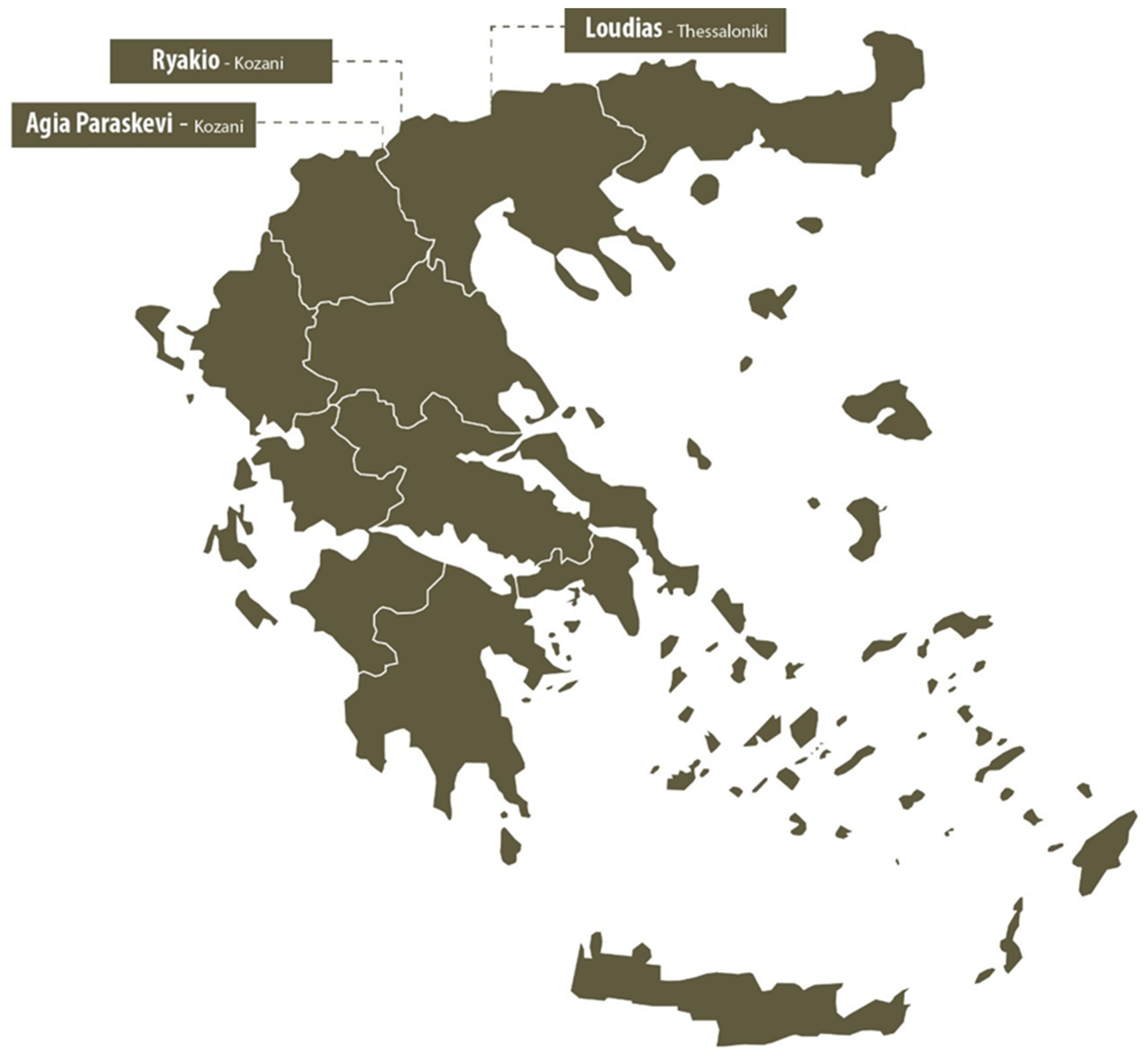
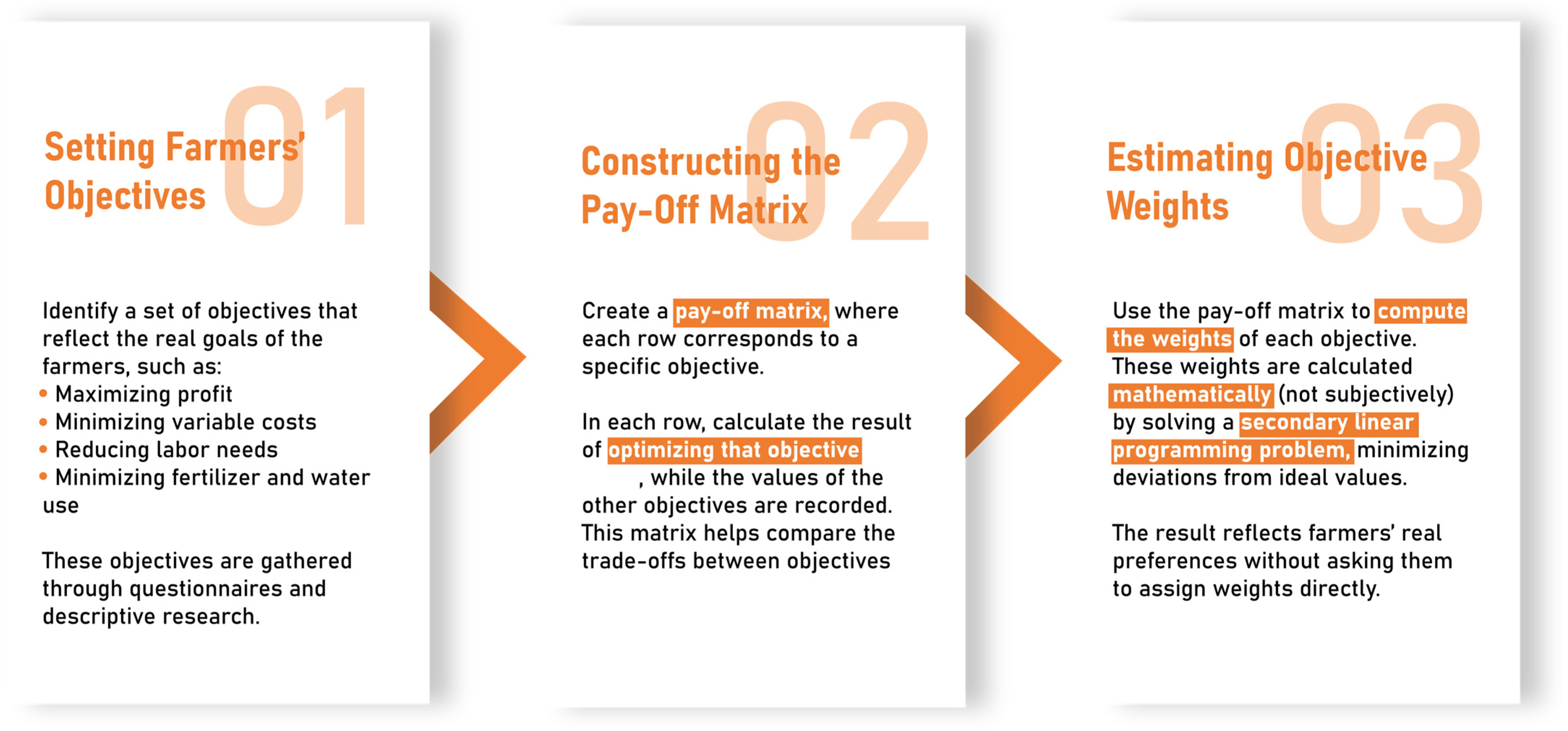
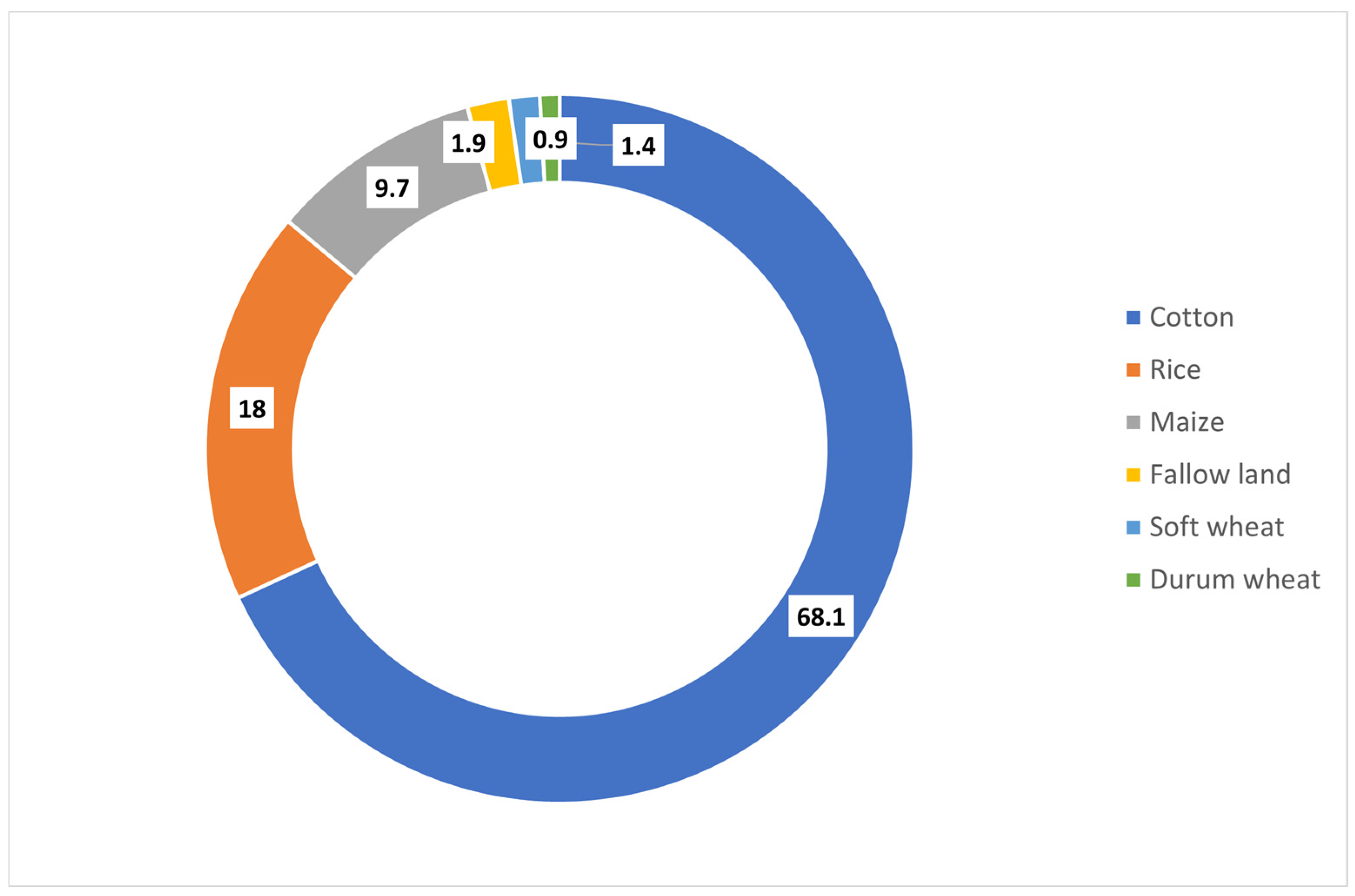

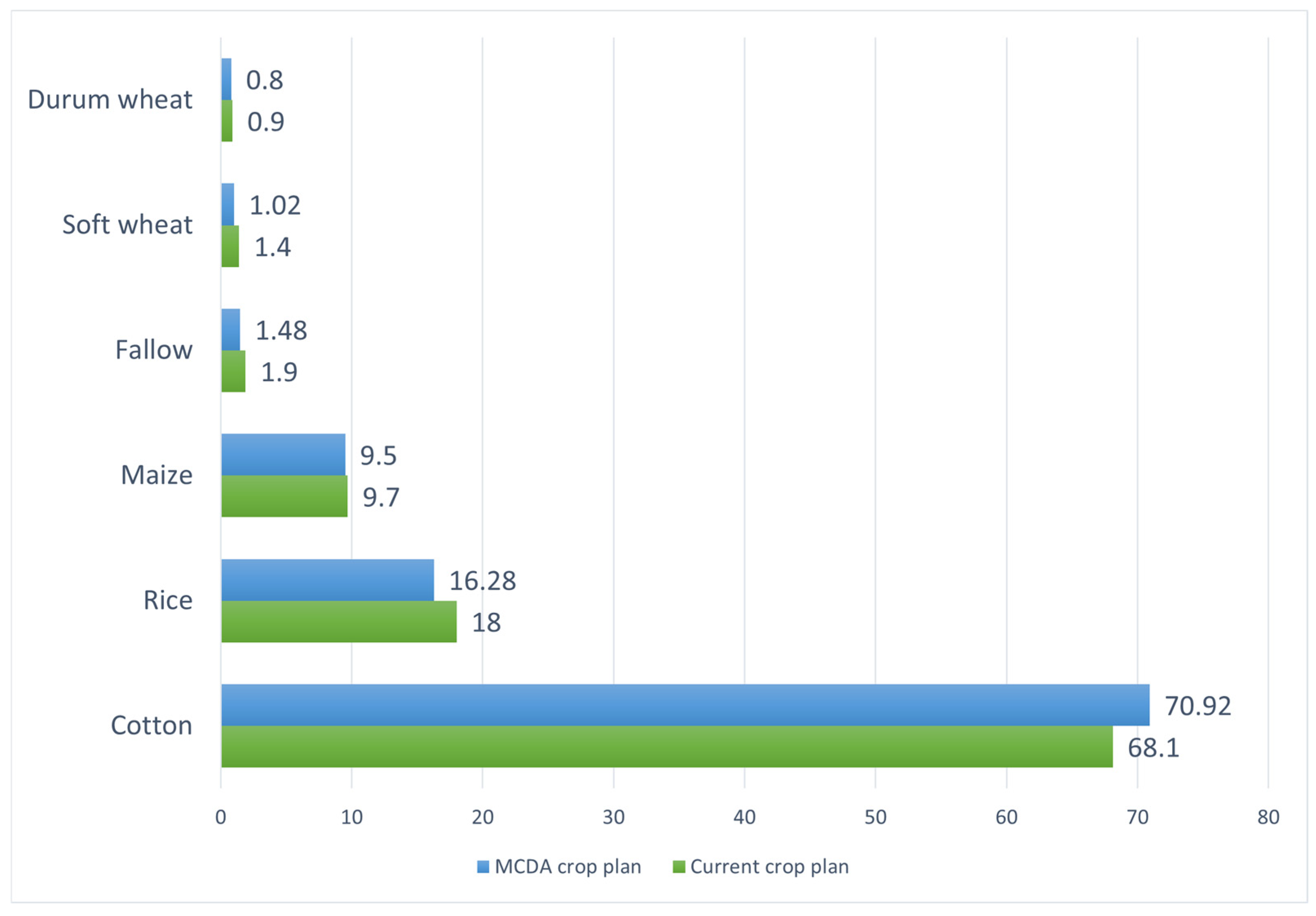
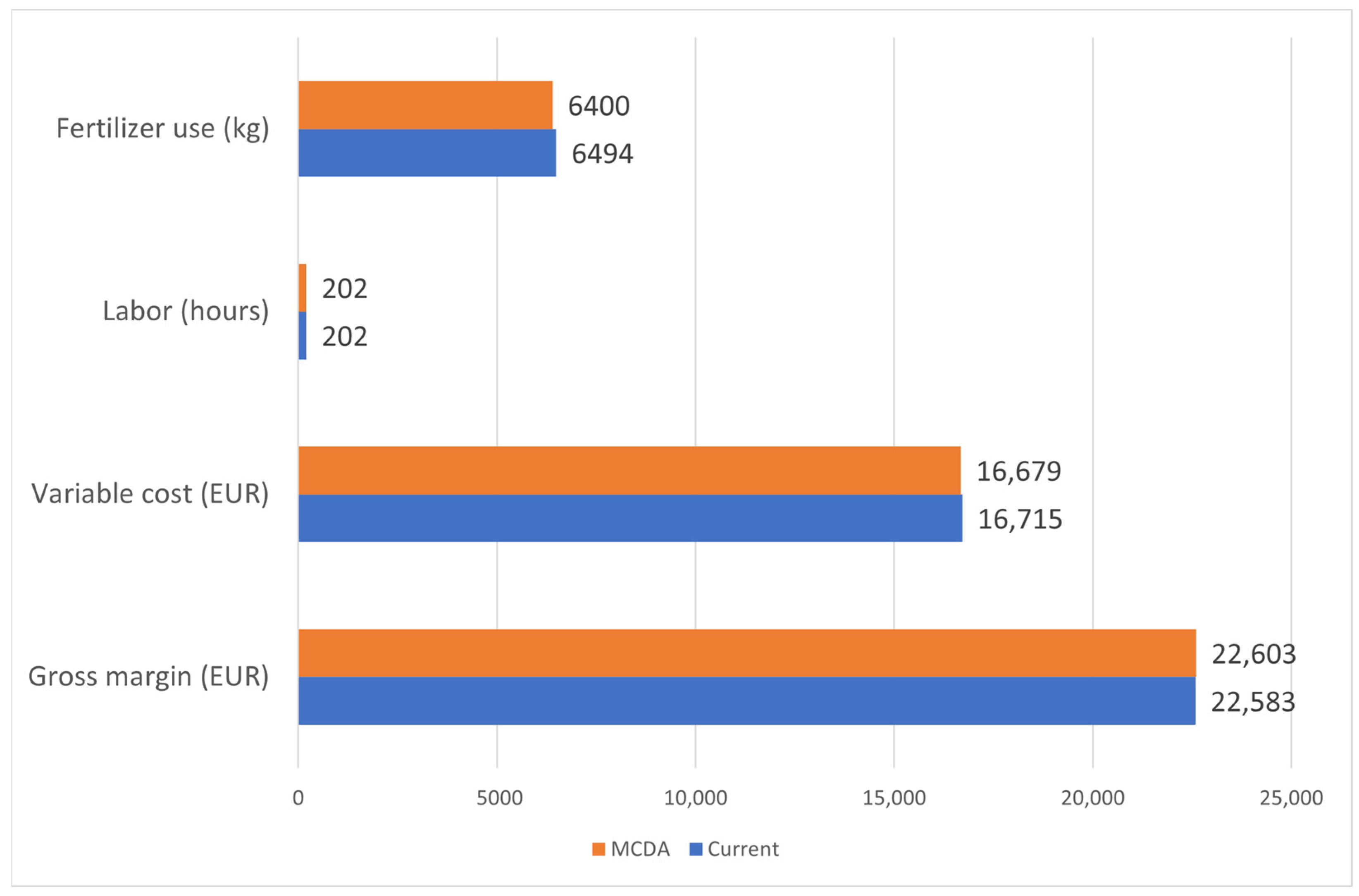

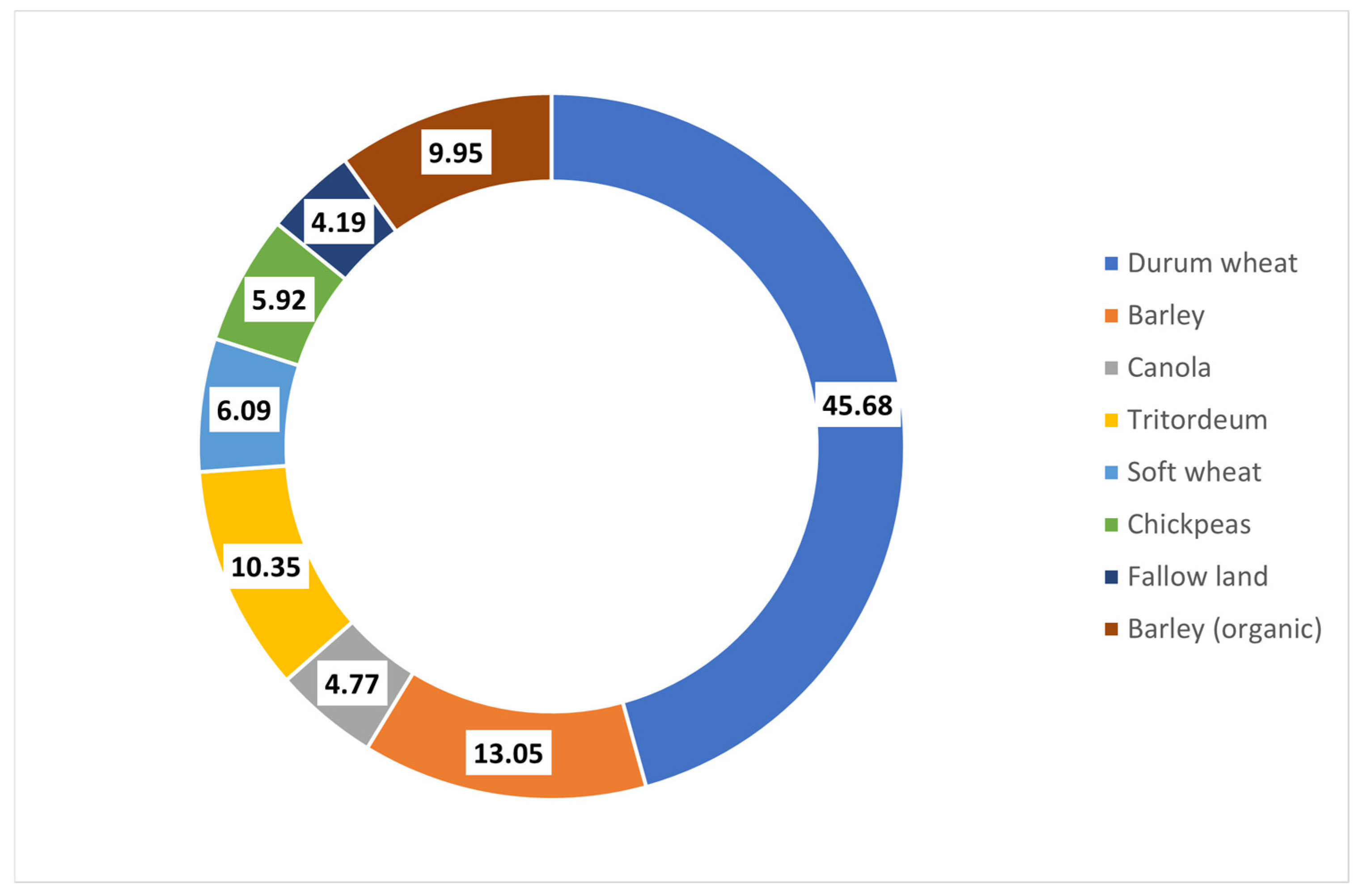


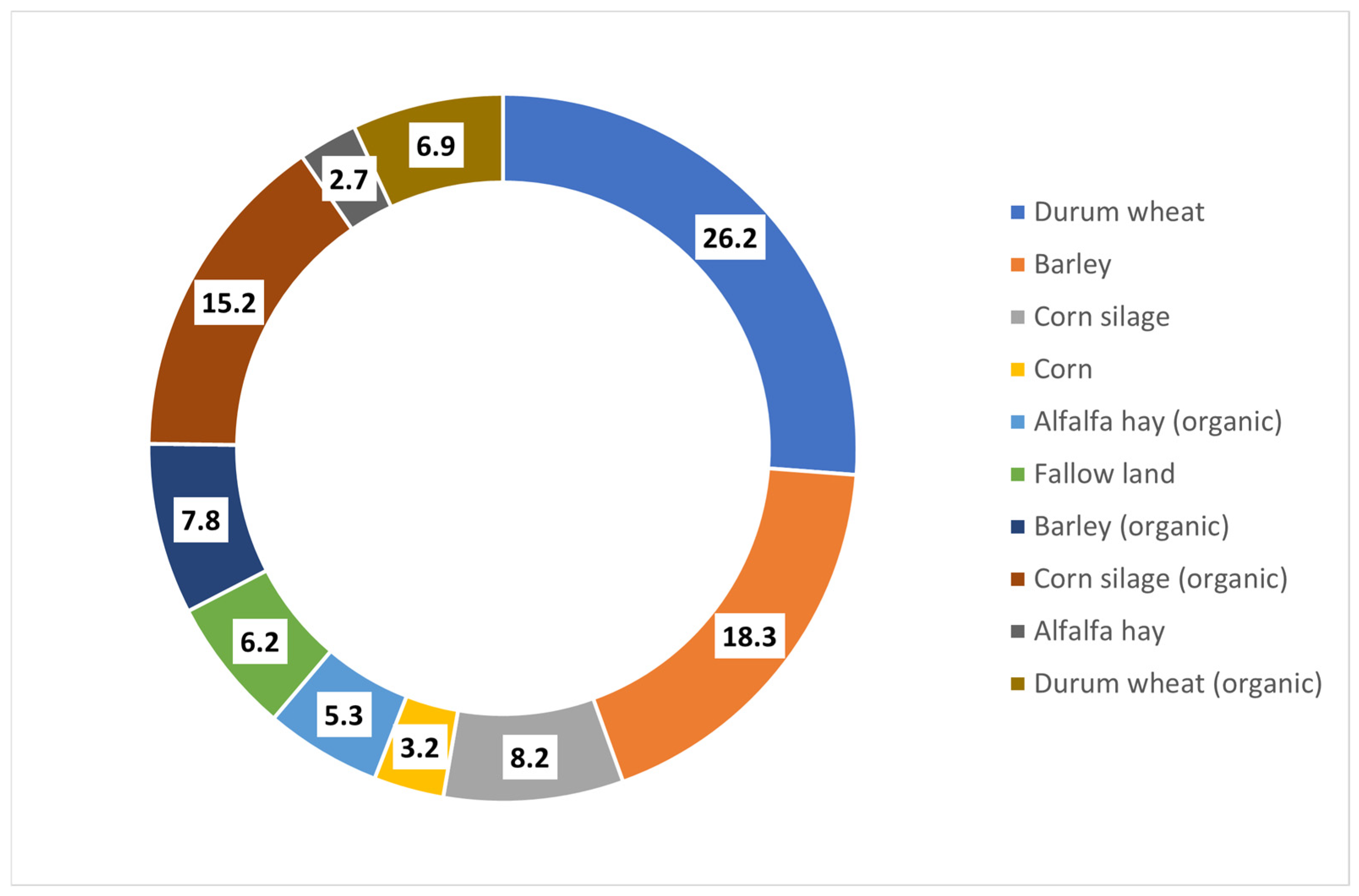
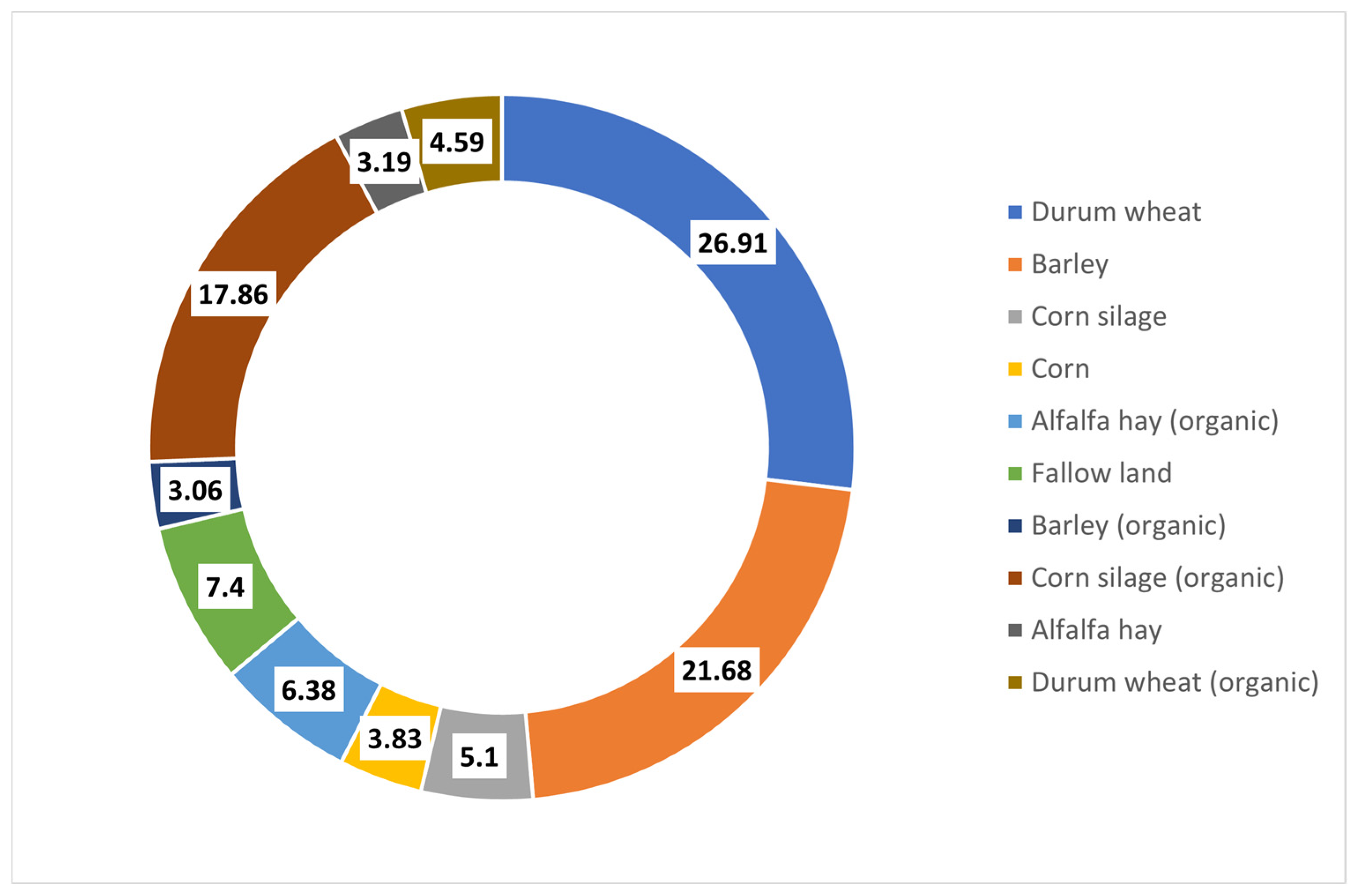

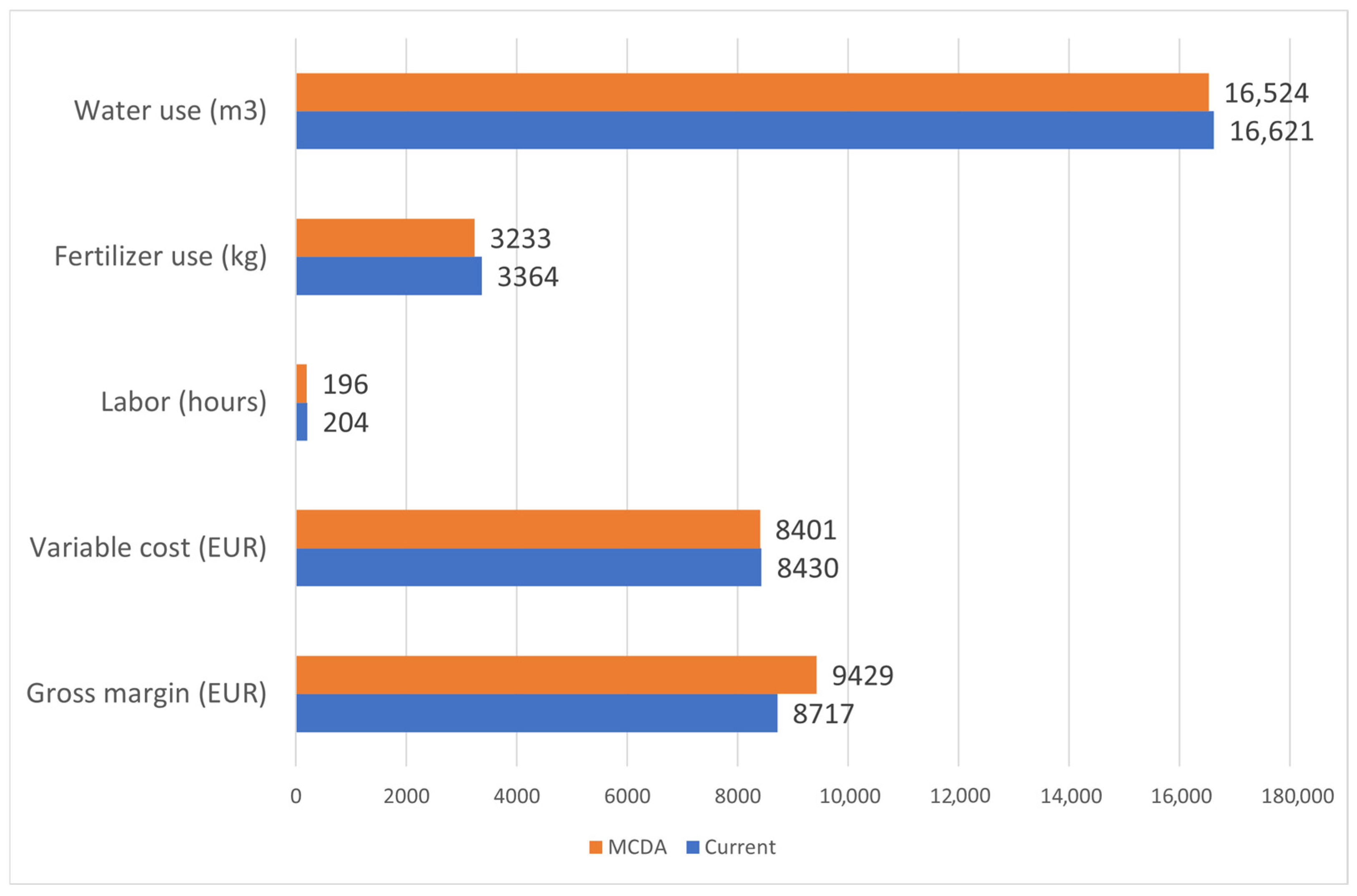
| Crop | Hectares | Current Crop Plan % | MCDA Crop Plan % | Deviation % |
|---|---|---|---|---|
| Cotton | 145.2 | 68.10 | 70.92 | +4.14 |
| Rice | 38.3 | 18.00 | 16.28 | −9.56 |
| Maize | 20.8 | 9.70 | 9.50 | −2.06 |
| Fallow land | 4.0 | 1.90 | 1.48 | −22.11 |
| Soft wheat | 3.0 | 1.40 | 1.02 | −27.14 |
| Durum wheat | 2.0 | 0.90 | 0.80 | −11.11 |
| Total | 213.3 | 100.00 | 100.00 |
| Current | MCDA | Deviation % | |
|---|---|---|---|
| Gross margin (EUR) | 22,583 | 22,603 | +0.09 |
| Variable cost (EUR) | 16,715 | 16,679 | −0.21 |
| Labor (hours) | 202 | 202 | 0 |
| Fertilizer use (kg) | 6494 | 6400 | −1.45 |
| Crop | Hectares | Current Crop Plan % | MCDA Crop Plan % | Deviation % |
|---|---|---|---|---|
| Durum wheat | 107.9 | 42.90 | 45.68 | 6.48 |
| Barley | 27.6 | 11.00 | 13.05 | 18.60 |
| Canola | 12.2 | 4.90 | 4.77 | −2.80 |
| Tritordeum | 27.3 | 10.90 | 10.35 | −5.13 |
| Soft wheat | 28.7 | 11.40 | 6.09 | −46.57 |
| Chickpeas | 14.6 | 5.80 | 5.92 | 2.06 |
| Fallow land | 8.4 | 3.30 | 4.19 | 26.96 |
| Barley (organic) | 24.6 | 9.80 | 9.95 | 1.50 |
| Total | 251.3 | 100.00 | 100.00 |
| Current | MCDA | Deviation % | |
|---|---|---|---|
| Gross margin (EUR) | 5378 | 6202 | +15.33 |
| Variable cost (EUR) | 8867 | 8825 | −0.47 |
| Labor (hours) | 203 | 201 | −0.94 |
| Fertilizer use (kg) | 3369 | 3315 | −1.33 |
| Crop | Hectares | Current Crop Plan % | MCDA Crop Plan % | Deviation % |
|---|---|---|---|---|
| Durum wheat | 20.6 | 26.20 | 26.91 | 2.70 |
| Barley | 14.3 | 18.30 | 21.68 | 18.46 |
| Corn silage | 6.5 | 8.20 | 5.10 | −37.80 |
| Corn | 2.5 | 3.20 | 3.83 | 19.68 |
| Alfalfa hay (organic) | 4.2 | 5.30 | 6.38 | 20.37 |
| Fallow land | 4.8 | 6.20 | 7.40 | 19.35 |
| Barley (organic) | 6.1 | 7.80 | 3.06 | −60.79 |
| Corn silage (organic) | 11.9 | 15.20 | 17.86 | 17.50 |
| Alfalfa hay | 2.1 | 2.70 | 3.19 | 18.14 |
| Durum wheat (organic) | 5.4 | 6.90 | 4.59 | −33.47 |
| Total | 78.4 | 100.00 | 100.00 | - |
| Current | MCDA | Deviation % | |
|---|---|---|---|
| Gross margin (EUR) | 8717 | 9429 | +8.18 |
| Variable cost (EUR) | 8430 | 8401 | −0.34 |
| Labor (hours) | 204 | 196 | −3.58 |
| Fertilizer use (kg) | 3364 | 3233 | −3.87 |
| Water use (m3) | 16,621 | 16,524 | −0.58 |
Disclaimer/Publisher’s Note: The statements, opinions and data contained in all publications are solely those of the individual author(s) and contributor(s) and not of MDPI and/or the editor(s). MDPI and/or the editor(s) disclaim responsibility for any injury to people or property resulting from any ideas, methods, instructions or products referred to in the content. |
© 2025 by the authors. Licensee MDPI, Basel, Switzerland. This article is an open access article distributed under the terms and conditions of the Creative Commons Attribution (CC BY) license (https://creativecommons.org/licenses/by/4.0/).
Share and Cite
Lialia, E.; Prentzas, A.; Tafidou, A.; Moulogianni, C.; Kouriati, A.; Dimitriadou, E.; Kleisiari, C.; Bournaris, T. Optimizing Agricultural Sustainability Through Land Use Changes Under the CAP Framework Using Multi-Criteria Decision Analysis in Northern Greece. Land 2025, 14, 1658. https://doi.org/10.3390/land14081658
Lialia E, Prentzas A, Tafidou A, Moulogianni C, Kouriati A, Dimitriadou E, Kleisiari C, Bournaris T. Optimizing Agricultural Sustainability Through Land Use Changes Under the CAP Framework Using Multi-Criteria Decision Analysis in Northern Greece. Land. 2025; 14(8):1658. https://doi.org/10.3390/land14081658
Chicago/Turabian StyleLialia, Evgenia, Angelos Prentzas, Anna Tafidou, Christina Moulogianni, Asimina Kouriati, Eleni Dimitriadou, Christina Kleisiari, and Thomas Bournaris. 2025. "Optimizing Agricultural Sustainability Through Land Use Changes Under the CAP Framework Using Multi-Criteria Decision Analysis in Northern Greece" Land 14, no. 8: 1658. https://doi.org/10.3390/land14081658
APA StyleLialia, E., Prentzas, A., Tafidou, A., Moulogianni, C., Kouriati, A., Dimitriadou, E., Kleisiari, C., & Bournaris, T. (2025). Optimizing Agricultural Sustainability Through Land Use Changes Under the CAP Framework Using Multi-Criteria Decision Analysis in Northern Greece. Land, 14(8), 1658. https://doi.org/10.3390/land14081658








